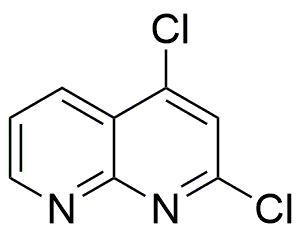2,4-Dichloro-1,8-naphthyridine is widely utilized in research focused on:
- Pesticide Development: This compound serves as a key intermediate in the synthesis of various agrochemicals, particularly herbicides and fungicides, which help in improving crop yields.
- Pharmaceutical Research: It is explored for its potential as an active pharmaceutical ingredient (API) in developing new medications, particularly those targeting bacterial infections.
- Material Science: The compound is used in creating advanced materials with specific properties, such as enhanced thermal stability and chemical resistance, beneficial in coatings and plastics.
- Analytical Chemistry: It acts as a standard reference material in chromatography and spectrometry, aiding researchers in the accurate analysis of complex mixtures.
- Environmental Studies: The chemical is studied for its behavior and degradation in various environmental conditions, contributing to understanding pollution and developing remediation strategies.
General Information
Properties
Safety and Regulations
Applications
2,4-Dichloro-1,8-naphthyridine is widely utilized in research focused on:
- Pesticide Development: This compound serves as a key intermediate in the synthesis of various agrochemicals, particularly herbicides and fungicides, which help in improving crop yields.
- Pharmaceutical Research: It is explored for its potential as an active pharmaceutical ingredient (API) in developing new medications, particularly those targeting bacterial infections.
- Material Science: The compound is used in creating advanced materials with specific properties, such as enhanced thermal stability and chemical resistance, beneficial in coatings and plastics.
- Analytical Chemistry: It acts as a standard reference material in chromatography and spectrometry, aiding researchers in the accurate analysis of complex mixtures.
- Environmental Studies: The chemical is studied for its behavior and degradation in various environmental conditions, contributing to understanding pollution and developing remediation strategies.
Documents
Safety Data Sheets (SDS)
The SDS provides comprehensive safety information on handling, storage, and disposal of the product.
Product Specification (PS)
The PS provides a comprehensive breakdown of the product’s properties, including chemical composition, physical state, purity, and storage requirements. It also details acceptable quality ranges and the product's intended applications.
Certificates of Analysis (COA)
Search for Certificates of Analysis (COA) by entering the products Lot Number. Lot and Batch Numbers can be found on a product’s label following the words ‘Lot’ or ‘Batch’.
*Catalog Number
*Lot Number
Certificates Of Origin (COO)
This COO confirms the country where the product was manufactured, and also details the materials and components used in it and whether it is derived from natural, synthetic, or other specific sources. This certificate may be required for customs, trade, and regulatory compliance.
*Catalog Number
*Lot Number
Safety Data Sheets (SDS)
The SDS provides comprehensive safety information on handling, storage, and disposal of the product.
DownloadProduct Specification (PS)
The PS provides a comprehensive breakdown of the product’s properties, including chemical composition, physical state, purity, and storage requirements. It also details acceptable quality ranges and the product's intended applications.
DownloadCertificates of Analysis (COA)
Search for Certificates of Analysis (COA) by entering the products Lot Number. Lot and Batch Numbers can be found on a product’s label following the words ‘Lot’ or ‘Batch’.
*Catalog Number
*Lot Number
Certificates Of Origin (COO)
This COO confirms the country where the product was manufactured, and also details the materials and components used in it and whether it is derived from natural, synthetic, or other specific sources. This certificate may be required for customs, trade, and regulatory compliance.


